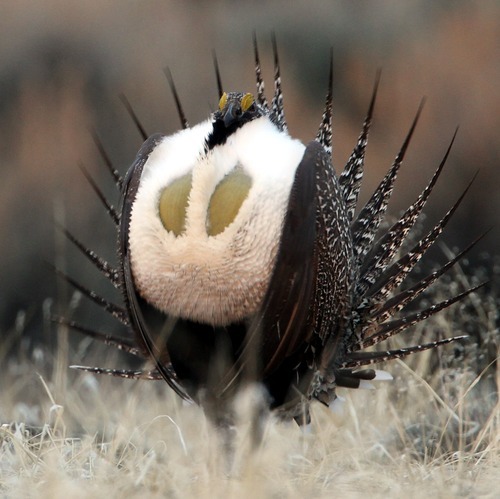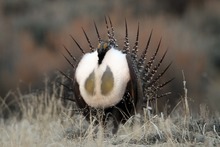This is an archived article that was published on sltrib.com in 2012, and information in the article may be outdated. It is provided only for personal research purposes and may not be reprinted.
A working group charged with developing recommendations for saving Utah's sage grouse appears stacked more toward saving industry, some environmentalists argue.
Of 18 members appointed by Gov. Gary Herbert — on recommendations from his public lands staff — only one represents a conservation group: The Nature Conservancy.
The oil and gas, oil shale, ranching and electric utility industries all have a place at the table, along with county and state officials backing economic development.
The team in coming months is expected to recommend ideas for a state management plan that can win U.S. Fish and Wildlife Service consent and forestall both an endangered-species listing for the bird and potentially costly federal land policies.
"The Fish and Wildlife Service has made it very clear that they will not accept a product that is not serious, that does not withstand scientific scrutiny," said Steve Bloch, a Southern Utah Wilderness Alliance attorney. "So when I look at the composition of this group ... it just strikes me that the state is not being serious in its effort."
The group also includes representatives from U.S. Fish and Wildlife Service, the Bureau of Land Management, the U.S. Forest Service and the Natural Resources Conservation Service.
"This is just a working advisory group," Herbert spokeswoman Ally Isom said, "not a policy group."
The group is suggesting issues to consider, and not actually formulating the plan, said John Harja, a Utah Department of Agriculture and Food official who is helping guide the process. That task will fall to the governor and his staff.
"It's not like at the end you're going to vote and create one product," Harja said of the working group.
The federal presence on the panel helps ensure the recommendations account for federal biologists' requirements, he said. "They've got to buy off on it."
But Wild Utah Project Executive Director Jim Catlin also sees the group as a "biased committee," with only two or three members with any expertise in grouse biology or management.
"Economic interests have the biggest role in this committee," he said, and it seems questionable that they would suggest measures favoring habitat, even if such habitat improvement ultimately helps ranchers.
Wild Utah Project biologist Allison Jones has attended the group's first two meetings and said it's "unbalanced" but may still reach acceptable conclusions, given the need to satisfy the Fish and Wildlife Service.
Wyoming rancher Bob Budd is leading the Utah group's sessions, reprising the role he has played in his home state's grouse conservation.
The Cowboy State created a plan that protects grouse in key areas of their range while exempting areas that already were important for coal, oil or gas development. Federal regulators accepted the plan, leaving grouse protection largely to the state for now.
A listing decision looms for Fish and Wildlife in 2015, though, and if the other 10 states with sage grouse don't similarly protect birds by then, it appears the sage grouse may become legally endangered — and its habitat strictly regulated — across its range.
In Wyoming, Budd leads a working group toward consensus decisions on how to tweak the rules as issues arise. He said he expects the same in Utah and believes the conservation community will be heard.
Harja said observers attending the meetings, including some from environmental groups, are welcome to raise issues.
Why grouse are declining
Greater sage grouse, once common throughout the Western sagebrush landscape, have been on a downward trend for more than a generation.
Biologists say habitat fragmentation — largely from energy development, subdivisions and other forces breaking up the sage stands — are largely to blame. But research also indicates threats from traffic or even towers and posts where predators may roost. Some interest groups blame overgrazing as well.
The males strut on the same flat breeding grounds each spring to attract mates, but each summer females may lead their broods for dozens of miles in search of greener vegetation and insects.





